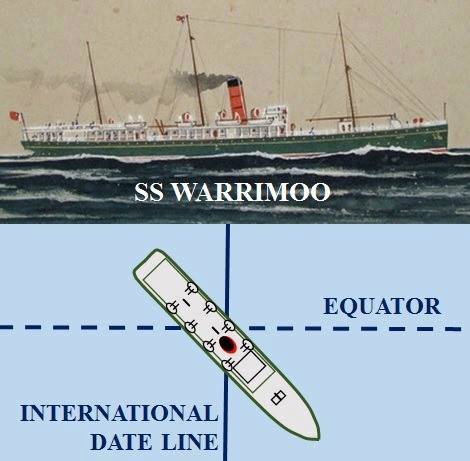The Warrimoo’s Mark in History
By James Donahue
In addition to its strange name, the New Zealand passenger ship Warrimoo and its crew hold the distinction of doing something nobody else may ever do . . . that is stand in two different places and in two different times at the same moment.
During a routine trip on the open Pacific Ocean, traveling from Vancouver to Australia on December 31, 1899, as the steamer was approaching the equator the ship’s navigator notified Captain John Phillips that they were also approaching the International Date Line.
This information inspired Captain Phillips to navigate the Warrimoo to the exact point that both equatorial and date lines crossed. The vessel enjoyed a calm sea that night making it possible for Phillips to pull off this stunt. After checking and double checking their position, the crew stopped the steamer so that it lay on the Equator at exactly the point where it crossed the International Date Line. Then they sat there, dead in the water until midnight.
As the magic moment arrived, the bow of the Warrimoo was in the Southern Hemisphere in the middle of summer, while the stern was in the Northern Hemisphere in the middle of winter.
Since it was the turn of the century, the aft part of the ship was still in December 31, 1899, while the men in the bow were singing Happy New Year because it was January 1, 1900.
Overall the ship was experiencing two different days, in two different months, in two different years, in two different seasons and two different centuries at that same moment!
Because this event occurred on a ship standing still in the middle of the open waters of the Pacific Ocean, it was a stunt that cannot be held again until the end of the Twenty-First Century, on December 31, 2099.
The Warrimoo’s name also gained much interest in its day. It was theorized that it was an Aboriginal name for “eagle.” The name was chosen by James Huddart, the ship’s builder, when it was launched in England in 1892 for the New Zealand-Australia Steamship Company. The Warrimoo had two sister ships, the Miowera and Aorangi. Do not ask where Huddart’s head was at when he chose these names.
The Warrimoo was an iron-hulled steamer, measuring an impressive 345-foot length and said to make heads turn in its day. It was built to carry both passengers and cargo between British-owned territories including Canada, England and the Southern Latitude ports.
In 1914 the Warrimoo served as a troop ship during the Great War and delivered the first Maori Pioneer troops to Gallipoli in 1915. The following year the ship was told to Khiam Yik & Co. Ltd in Singapore.
The Warrimoo came to a sensational end while steaming in convoy from Bizerta to Marselle. On May 17, 1918 there was a collision with the French warship Catapulte. The Catapulte blew up. The blast sank both ships and killed a number of sailors.
By James Donahue
In addition to its strange name, the New Zealand passenger ship Warrimoo and its crew hold the distinction of doing something nobody else may ever do . . . that is stand in two different places and in two different times at the same moment.
During a routine trip on the open Pacific Ocean, traveling from Vancouver to Australia on December 31, 1899, as the steamer was approaching the equator the ship’s navigator notified Captain John Phillips that they were also approaching the International Date Line.
This information inspired Captain Phillips to navigate the Warrimoo to the exact point that both equatorial and date lines crossed. The vessel enjoyed a calm sea that night making it possible for Phillips to pull off this stunt. After checking and double checking their position, the crew stopped the steamer so that it lay on the Equator at exactly the point where it crossed the International Date Line. Then they sat there, dead in the water until midnight.
As the magic moment arrived, the bow of the Warrimoo was in the Southern Hemisphere in the middle of summer, while the stern was in the Northern Hemisphere in the middle of winter.
Since it was the turn of the century, the aft part of the ship was still in December 31, 1899, while the men in the bow were singing Happy New Year because it was January 1, 1900.
Overall the ship was experiencing two different days, in two different months, in two different years, in two different seasons and two different centuries at that same moment!
Because this event occurred on a ship standing still in the middle of the open waters of the Pacific Ocean, it was a stunt that cannot be held again until the end of the Twenty-First Century, on December 31, 2099.
The Warrimoo’s name also gained much interest in its day. It was theorized that it was an Aboriginal name for “eagle.” The name was chosen by James Huddart, the ship’s builder, when it was launched in England in 1892 for the New Zealand-Australia Steamship Company. The Warrimoo had two sister ships, the Miowera and Aorangi. Do not ask where Huddart’s head was at when he chose these names.
The Warrimoo was an iron-hulled steamer, measuring an impressive 345-foot length and said to make heads turn in its day. It was built to carry both passengers and cargo between British-owned territories including Canada, England and the Southern Latitude ports.
In 1914 the Warrimoo served as a troop ship during the Great War and delivered the first Maori Pioneer troops to Gallipoli in 1915. The following year the ship was told to Khiam Yik & Co. Ltd in Singapore.
The Warrimoo came to a sensational end while steaming in convoy from Bizerta to Marselle. On May 17, 1918 there was a collision with the French warship Catapulte. The Catapulte blew up. The blast sank both ships and killed a number of sailors.

